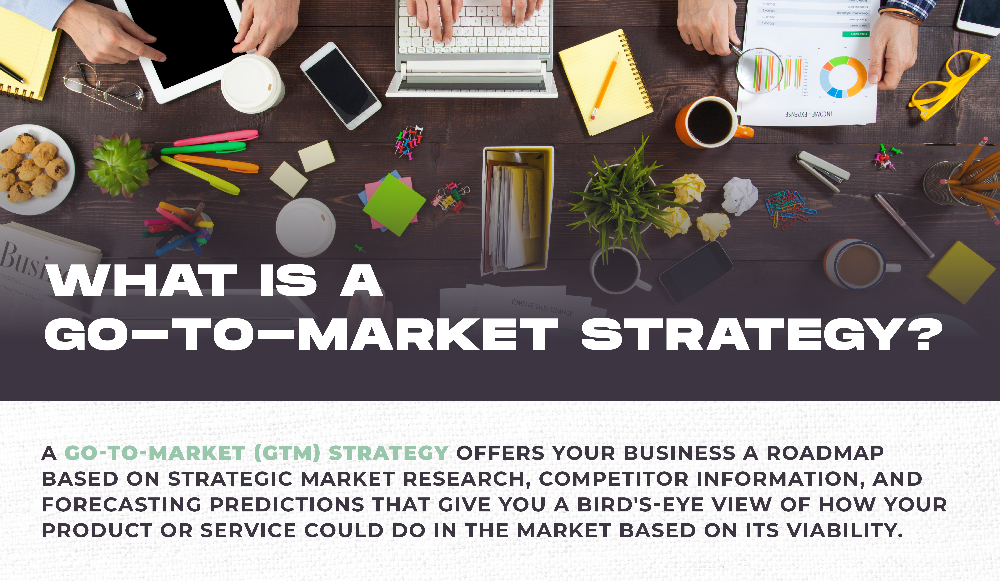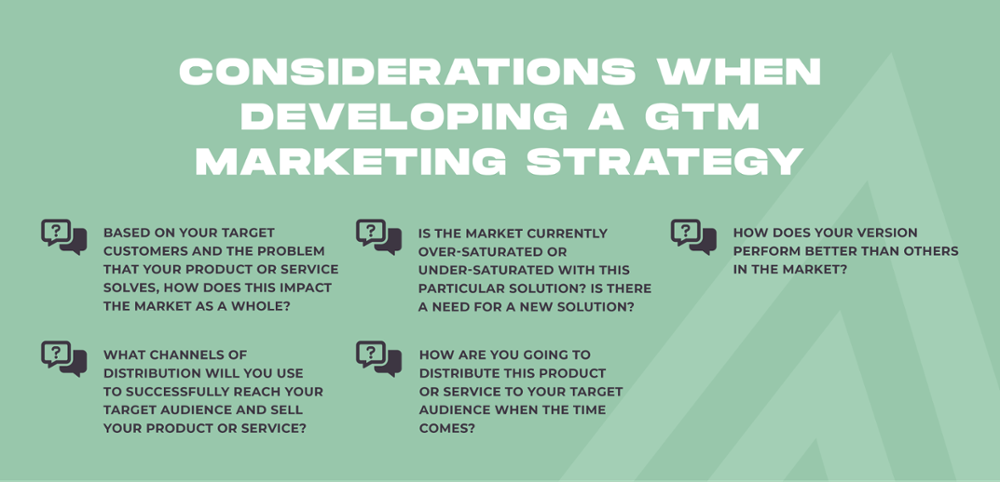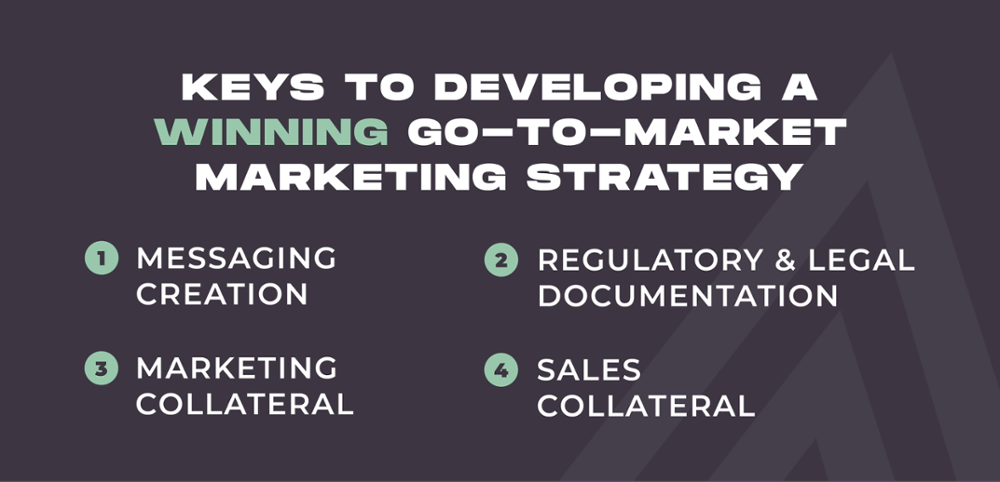Imagine this … your company has spent the last few months carefully developing and testing a new product or service.
Now, it’s almost time for the official launch, but several key components need to be in line before the big day comes around. After spending so much time and energy on your new product or service, the last thing you want to do is launch it without a plan of action.
That’s where your go-to-market strategy comes into play.
What Is a Go-to-Market Strategy?
A go-to-market (GTM) strategy offers your business a roadmap based on strategic market research, competitor information, and forecasting predictions that give you a bird's-eye view of how your product or service could do in the market based on its viability. 
GTM strategies create a practical guideline for your team to follow when approaching customers about this new product or service and offer them the tools needed to influence buying decisions in a strategic way.
They’re a crucial part of the overall launch process because they allow you to hone in on your intended target audience, timeline to market, and specific market segment. In other words, without a comprehensive GTM strategy, it’s impossible to know if you’re reaching the wrong audience, entering the market at the wrong time, or targeting an oversaturated market.
And it’s not just for new products — go-to-market strategies are important for new and rebranded products or services, as well as for introducing your products into new markets.
They’re also not just limited to physical products. A strong GTM strategy is extremely helpful for launching new SaaS or service solutions, announcing the opening of a new branch of your organization, or the launch of a brand new business.
Considerations When Developing a GTM Marketing Strategy

A strong marketing strategy outlines how your company can achieve and maintain its competitive advantages from inception to years beyond. But to do this successfully, first, you must understand your target market.
- What stage of life are they currently in?
- What do they value — both emotionally and monetarily?
- What problems are they looking to solve?
- How are your competitors solving this problem?
- How does your product or service solve that problem better than the competition?
By asking yourself these questions, you can begin to shape your ideal customer persona in your mind.
Once you’re clear on who your perfect audience is, you can begin to consider the additional elements necessary to build a strong go-to-market strategy. Brainstorm the following questions with your team to start creating a GTM framework:
- Based on your target customers and the problem that your product or service solves, how does this impact the market as a whole?
- Is the market currently over-saturated or under-saturated with this particular solution? Is there a need for a new solution?
- How does your version perform better than others in the market?
- What channels of distribution will you use to successfully reach your target audience and sell your product or service?
- How are you going to distribute this product or service to your target audience when the time comes?
Answering each of these questions comprehensively will help your team to build a solid go-to-market strategy based on real research and an in-depth understanding of where your business, audience, and product stand in the market.
Then, by positioning your new product or solution effectively, customers will see the inherent value it offers them and be ready to invest in it.
4 Key Elements of a Successful Go-to-Market Strategy

To achieve effective market positioning, you need to make sure your potential customers understand exactly what you're offering. Here are four key elements that will help connect the dots for potential buyers.
1. Messaging Creation
Messaging is one of the most crucial elements of a successful (or failed) product or service launch. It will make or break your audiences’ initial experience with your product and its usefulness for their individual lives, its positioning in the market, and your overall brand.
Start by developing a unique value proposition that details what makes your product or service different, unique, and essential for your target audience. Focus on the benefits of your product or service, as well as how they differentiate from your competition, and communicate these concepts clearly in your marketing collateral.
2. Regulatory and Legal Documentation
If you’re planning a product launch in the SaaS space, the creation of legal documentation that discusses privacy standards and regulatory compliances may be necessary to position your product or solution as safe, vetted, and capable of solving the issue at hand while still maintaining compliance with any regulatory requirements.
3. Marketing Collateral
Is marketing collateral essential for a go-to-market strategy? Yes!
Since a GTM strategy is designed to make sure your product gets into the hands of the right audience, it’s crucial to have the right marketing assets in place before launch. This includes any type of digital or printed material that effectively communicates or promotes your company's brand message as well as its new products or services.
This marketing collateral can be presented in a wide variety of formats, such as brochures, point-of-sale posters, videos, e-Books, newsletters, and graphics. When determining which specific type of marketing collateral is right for your go-to-market strategy, it’s important to think about what you want to achieve with your collateral. Ask yourself:
- Are you educating your audience about the product’s or service’s specs?
- Are you educating your audience about the benefits of your product or service?
- How are you positioning your product or service within the market?
Based on your answers to these questions, you’ll determine the types of marketing collateral that will speak to your audience impactfully across a variety of distribution channels.
4. Sales Collateral
Your sales team will also need collateral that effectively communicates the value of your products or solutions to prospective leads, giving them the tools to evaluate, decide, and eventually purchase.
Sales collateral can include things like product videos and video demonstrations, customer testimonials and case studies, product brochures with technical specifications, or videos of your product or solution in action. Sales collateral should be stronger and more fact-based than the marketing collateral that draws customers in initially.
The Importance of Marketing and Sales Alignment in GTM Strategies
The most important step in aligning both marketing and sales within your organization is by establishing open and shared communication around the overall strategy, goals, and processes necessary to operate as a fully-integrated team.
When aligned, both teams can deliver high-impact marketing collateral and activities, boost sales effectiveness, and ultimately grow company revenue. In fact, your marketing team may be able to help the sales team shorten the sales cycle and go to market faster. This is beneficial for day-to-day activities within the company but especially for making sure GTM initiatives flourish.
As the B2B buying cycle continues to evolve, customer relationships are also radically shifting. Cold calls and cold emails aren’t effective sales tools any longer and can negatively impact your ability to reach potential customers.
This shift is requiring sales and marketing professionals to work hand-in-hand to shorten the sales cycle and meet customers where they are. It’s one of the most crucial components of your go-to-market strategy.
LAIRE Can Help
We understand that a comprehensive go-to-market strategy requires a lot of moving pieces, especially when it comes to aligning your business’s sales and marketing efforts and collateral. Launching a product successfully all comes down to starting somewhere — even when you don’t know where to start.
As an award-winning digital growth agency, LAIRE has partnered with a variety of B2B brands across the country who are seeking to not only create a successful go-to-market strategy for a particular product or service but also to enable better sales and marketing alignment throughout their business.
Let us help you identify the right target audience, craft a strong unique value proposition, and build up your sales and marketing collateral databases, all while streamlining your sales cycle from start to finish. Together, we’ll ensure your company has what it needs for a successful launch of any product or service, regardless of your industry.


